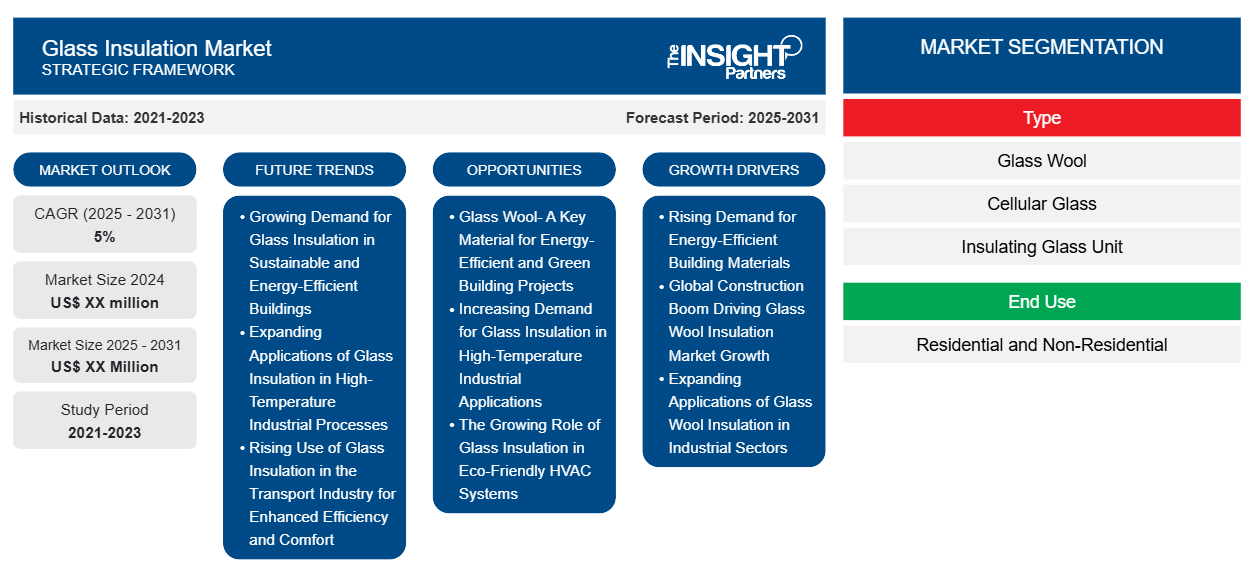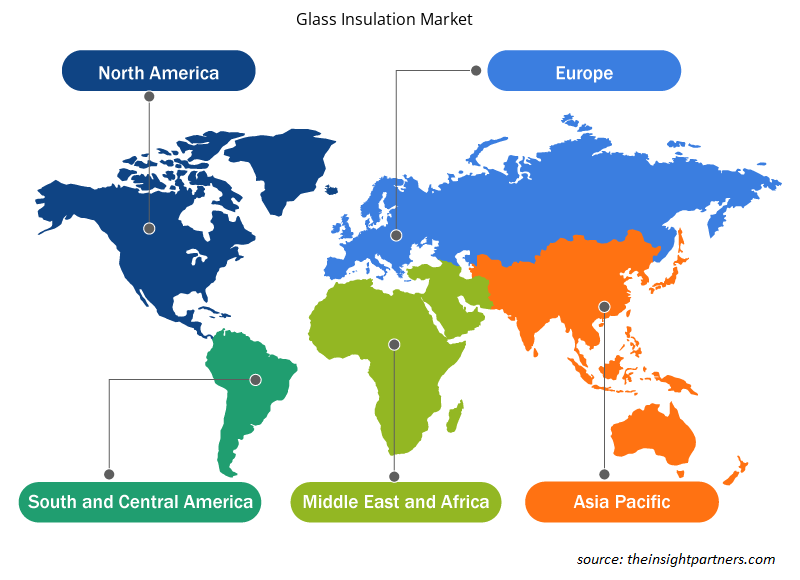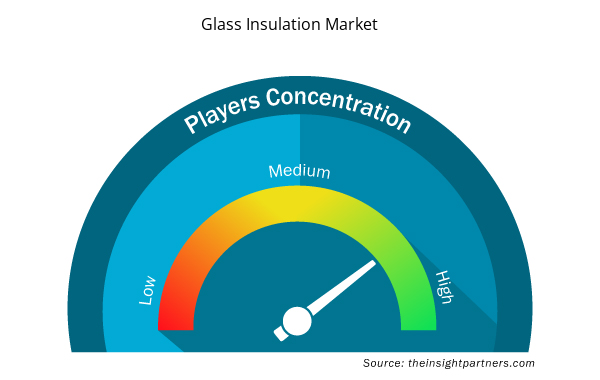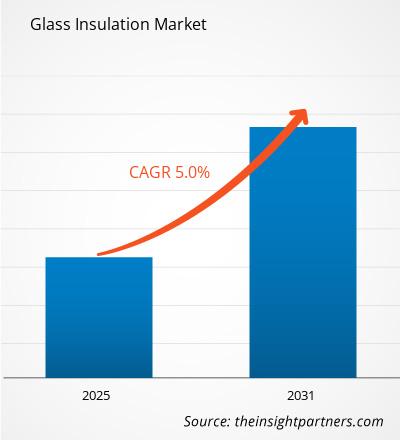Le marché de l'isolation en verre devrait enregistrer un TCAC de 5 % de 2025 à 2031, avec une taille de marché passant de XX millions USD en 2024 à XX millions USD d'ici 2031.
Le rapport est segmenté par type (laine de verre, verre cellulaire et unité de vitrage isolant). L'analyse globale est ensuite ventilée au niveau régional et par principaux pays. Le rapport présente en outre une analyse basée sur l'utilisation finale (résidentielle et non résidentielle). L'analyse globale est ensuite ventilée au niveau régional et par principaux pays. La taille du marché et les prévisions aux niveaux mondial, régional et national pour tous les segments de marché clés sont couvertes dans le cadre du périmètre. Le rapport offre la valeur en USD pour l'analyse et les segments ci-dessus. Le rapport fournit des statistiques clés sur l'état du marché des principaux acteurs du marché et offre des tendances et des opportunités de marché.
Objectif du rapport
Le rapport sur le marché de l'isolation en verre de The Insight Partners vise à décrire le paysage actuel et la croissance future, les principaux facteurs moteurs, les défis et les opportunités. Cela fournira des informations à diverses parties prenantes commerciales, telles que :
- Fournisseurs/fabricants de technologie : pour comprendre l’évolution de la dynamique du marché et connaître les opportunités de croissance potentielles, leur permettant de prendre des décisions stratégiques éclairées.
- Investisseurs : Effectuer une analyse complète des tendances concernant le taux de croissance du marché, les projections financières du marché et les opportunités qui existent tout au long de la chaîne de valeur.
- Organismes de réglementation : Réglementer les politiques et surveiller les activités du marché dans le but de minimiser les abus, de préserver la confiance des investisseurs et de maintenir l’intégrité et la stabilité du marché.
Segmentation du marché de l'isolation en verre
Taper
- Laine de verre
- Verre cellulaire
- Vitrage isolant
Utilisation finale
- Résidentiel et non résidentiel
Personnalisez ce rapport en fonction de vos besoins
Vous bénéficierez d'une personnalisation gratuite de n'importe quel rapport, y compris de certaines parties de ce rapport, d'une analyse au niveau des pays, d'un pack de données Excel, ainsi que de superbes offres et réductions pour les start-ups et les universités.
Marché de l'isolation en verre : perspectives stratégiques

- Obtenez les principales tendances clés du marché de ce rapport.Cet échantillon GRATUIT comprendra une analyse de données, allant des tendances du marché aux estimations et prévisions.
Facteurs de croissance du marché de l'isolation en verre
- Demande croissante de matériaux de construction économes en énergie : En raison de l'augmentation des prix de l'énergie et des facteurs de changement climatique, il existe un besoin croissant de matériaux de construction économes en énergie. La laine de verre possède des propriétés d'isolation thermique et acoustique très efficaces, minimisant ainsi le gaspillage d'énergie dans les bâtiments résidentiels et commerciaux. Alors que de plus en plus d'économies améliorent l'application des normes de réglementation énergétique, ces isolations deviennent pertinentes.insulations get to be of relevance.
- L'essor mondial de la construction stimule la croissance du marché de l'isolation en laine de verre : L'expansion inexplicable du marché de l'isolation en verre est attribuée à l'expansion de l'industrie de la construction au niveau mondial. L'urbanisation étant rapide, de nouveaux bâtiments résidentiels, industriels et commerciaux sont nécessaires, ce qui nécessite automatiquement des matériaux isolants. À cet égard, l'isolation en verre facilite l'efficacité énergétique tant dans les nouvelles installations que dans les travaux de rénovation.unexplainable expansion of the glass insulation market is attributed to the expansion of the construction industry at the global level. Since urbanization is rapid, novel, residential, industrial and commercial buildings are needed which automatically calls for insulation materials. In this respect, glass insulation facilitates energy efficiency in both new installations and retrofit works.
- Expansion des applications de l'isolation en laine de verre dans les secteurs industriels : Outre son utilisation dans les maisons et les bureaux, l'isolation en verre gagne en popularité dans les secteurs industriels tels que la fabrication, l'automobile et même la pétrochimie. La résistance à la chaleur et les limites de fonctionnement à haute température tendent à permettre son utilisation dans des endroits tels que l'isolation des canalisations, les chambres de four et les systèmes CVC.
Tendances futures du marché de l'isolation en verre
- Demande croissante d'isolation en verre dans les bâtiments durables et économes en énergie : L'importance croissante accordée à la construction de structures économes en énergie et durables va stimuler la demande d'isolation en verre. Alors que des règles de plus en plus strictes en matière d'utilisation de l'énergie sont mises en place, l'isolation en verre possède une excellente isolation thermique et acoustique, c'est pourquoi elle est également largement utilisée pour économiser l'énergie et améliorer le confort et l'efficacité des structures résidentielles et commerciales.
- Expansion des applications de l'isolation en verre dans les processus industriels à haute température : l'isolation en verre est susceptible de gagner en acceptation et en utilisation dans les processus industriels tels que les centrales électriques, les raffineries de pétrole et le traitement chimique où la résistance aux températures extrêmement élevées et la sécurité sont essentielles. Par exemple, la laine de verre ainsi que d'autres systèmes d'isolation en verre sont efficaces dans les domaines nécessitant une isolation thermique, un contrôle du bruit et également une protection contre les incendies.
- Utilisation croissante de l'isolation en verre dans l'industrie du transport pour une efficacité et un confort accrus : Le secteur de l'isolation en verre devrait croître en raison de l'utilisation accrue de matériaux isolants dans l'industrie du transport visant à améliorer l'efficacité énergétique et le confort. Plus précisément, l'isolation en verre sera de plus en plus utilisée dans les véhicules tels que les trains, les bus et les navires en raison de sa légèreté, de sa résilience et de la réduction des pertes d'énergie dans les systèmes de chauffage et de refroidissement.
Opportunités de marché pour l'isolation en verre
- La laine de verre, un matériau essentiel pour les projets de construction écologiques et économes en énergie : Compte tenu de la préoccupation croissante de réduire la consommation d'énergie dans la construction et l'exploitation des bâtiments, la laine de verre a tout à gagner. Il s'agit d'un matériau économe en énergie, idéal pour une utilisation dans les bâtiments résidentiels et commerciaux, car il améliore non seulement l'efficacité énergétique, mais fournit également une isolation thermique et acoustique qui est essentielle aux projets de construction écologique. Et l'accent mis sur des conceptions de bâtiments plus adaptatives conduira à une plus grande acceptation de l'isolation en verre.
- Demande croissante d'isolation en verre dans les applications industrielles à haute température : l'isolation en verre est de plus en plus pertinente dans les applications industrielles à haute température, notamment, mais sans s'y limiter, les usines à gaz, les raffineries de pétrole et les usines chimiques. Grâce à la capacité du matériau à remplir sa fonction thermique même à des températures extrêmes tout en étant résistant à toute forme de dégradation, l'isolation thermique devient une nécessité dans les industries lourdes, ce qui ouvre un bon marché dans ce domaine.
- Le rôle croissant de l'isolation en verre dans les systèmes CVC respectueux de l'environnement : L'avancement des systèmes CVC a également contribué à l'augmentation de la demande d'isolation en verre pour les systèmes de chauffage, de ventilation et de climatisation, améliorant ainsi l'efficacité des dépenses énergétiques. Le mouvement vers des systèmes CVC économes en énergie et respectueux de l'environnement constitue une opportunité croissante pour les fabricants d'isolation en verre sur les marchés résidentiel et commercial.
Aperçu régional du marché de l'isolation en verre
Les tendances et facteurs régionaux influençant le marché de l’isolation en verre tout au long de la période de prévision ont été expliqués en détail par les analystes d’Insight Partners. Cette section traite également des segments et de la géographie du marché de l’isolation en verre en Amérique du Nord, en Europe, en Asie-Pacifique, au Moyen-Orient et en Afrique, ainsi qu’en Amérique du Sud et en Amérique centrale.

- Obtenez les données régionales spécifiques au marché de l'isolation en verre
Portée du rapport sur le marché de l'isolation en verre
| Attribut de rapport | Détails |
|---|---|
| Taille du marché en 2024 | XX millions de dollars américains |
| Taille du marché d'ici 2031 | XX millions de dollars américains |
| Taux de croissance annuel composé mondial (2025-2031) | 5% |
| Données historiques | 2021-2023 |
| Période de prévision | 2025-2031 |
| Segments couverts | Par type
|
| Régions et pays couverts | Amérique du Nord
|
| Leaders du marché et profils d'entreprises clés |
|
Densité des acteurs du marché de l'isolation en verre : comprendre son impact sur la dynamique commerciale
Le marché de l'isolation en verre connaît une croissance rapide, tirée par la demande croissante des utilisateurs finaux en raison de facteurs tels que l'évolution des préférences des consommateurs, les avancées technologiques et une plus grande sensibilisation aux avantages du produit. À mesure que la demande augmente, les entreprises élargissent leurs offres, innovent pour répondre aux besoins des consommateurs et capitalisent sur les tendances émergentes, ce qui alimente davantage la croissance du marché.
La densité des acteurs du marché fait référence à la répartition des entreprises ou des sociétés opérant sur un marché ou un secteur particulier. Elle indique le nombre de concurrents (acteurs du marché) présents sur un espace de marché donné par rapport à sa taille ou à sa valeur marchande totale.
Les principales entreprises opérant sur le marché de l'isolation en verre sont :
- Nippon Sheet Glass Co., Ltd.
- Owens Corning
- PPG Industries, Inc.
- Société CertainTeed
Avis de non-responsabilité : les sociétés répertoriées ci-dessus ne sont pas classées dans un ordre particulier.

- Obtenez un aperçu des principaux acteurs du marché de l'isolation en verre
Principaux arguments de vente
- Couverture complète : Le rapport couvre de manière exhaustive l’analyse des produits, des services, des types et des utilisateurs finaux du marché de l’isolation en verre, offrant un paysage holistique.
- Analyse d’experts : Le rapport est compilé sur la base d’une compréhension approfondie des experts et analystes du secteur.
- Informations à jour : Le rapport garantit la pertinence commerciale en raison de sa couverture des informations récentes et des tendances des données.
- Options de personnalisation : ce rapport peut être personnalisé pour répondre aux exigences spécifiques du client et s'adapter parfaitement aux stratégies commerciales.
Le rapport de recherche sur le marché de l’isolation en verre peut donc aider à ouvrir la voie au décodage et à la compréhension du scénario de l’industrie et des perspectives de croissance. Bien qu’il puisse y avoir quelques préoccupations valables, les avantages globaux de ce rapport ont tendance à l’emporter sur les inconvénients.
- Analyse historique (2 ans), année de base, prévision (7 ans) avec TCAC
- Analyse PEST et SWO
- Taille du marché Valeur / Volume - Mondial, Régional, Pays
- Industrie et paysage concurrentiel
- Ensemble de données Excel


- Enteral Nutrition Market
- Diaper Packaging Machine Market
- Health Economics and Outcome Research (HEOR) Services Market
- Transdermal Drug Delivery System Market
- Helicopters Market
- Visualization and 3D Rendering Software Market
- Digital Language Learning Market
- Grant Management Software Market
- Vertical Farming Crops Market
- Dairy Flavors Market

Report Coverage
Revenue forecast, Company Analysis, Industry landscape, Growth factors, and Trends

Segment Covered
This text is related
to segments covered.

Regional Scope
North America, Europe, Asia Pacific, Middle East & Africa, South & Central America

Country Scope
This text is related
to country scope.
Questions fréquemment posées
Growing demand for green and energy-efficient buildings is expected to be the key market trends
Based on type, the glass wool segment is expected to witness the fastest growth during the forecast period
Based on geography, Asia Pacific held the largest share of the glass insulation market due to the well-established construction industry across the region, coupled with continuous growth and development
Increasing awareness of energy efficiency and sustainability is driving the market growth
Owens Corning
; Saint-Gobain Group
; Rockwool International A/S
; Knauf Insulation
; Johns Manville
; Kingspan Group
; BASF SE
; Paroc Group
; Isotherm
; Uralita S.A.
; Huntsman Corporation
; Thermo-Block
; Effisus
; Fletcher Insulation
; Owosso Motor Company
The Glass Insulation Market is estimated to witness a CAGR of 5% from 2023 to 2031
Trends and growth analysis reports related to Chemicals and Materials : READ MORE..
The List of Companies
1. Nippon Sheet Glass Co Ltd.
2. Owens Corning
3. PPG Industries, Inc.
4. Certain Teed Corporation
5. Pittsburgh Corning Corporation
6. Saint-Gobain
7. AFICO
8. Johns Manville
9. Knauf
10. Scheuten Glas
The Insight Partners performs research in 4 major stages: Data Collection & Secondary Research, Primary Research, Data Analysis and Data Triangulation & Final Review.
- Data Collection and Secondary Research:
As a market research and consulting firm operating from a decade, we have published and advised several client across the globe. First step for any study will start with an assessment of currently available data and insights from existing reports. Further, historical and current market information is collected from Investor Presentations, Annual Reports, SEC Filings, etc., and other information related to company’s performance and market positioning are gathered from Paid Databases (Factiva, Hoovers, and Reuters) and various other publications available in public domain.
Several associations trade associates, technical forums, institutes, societies and organization are accessed to gain technical as well as market related insights through their publications such as research papers, blogs and press releases related to the studies are referred to get cues about the market. Further, white papers, journals, magazines, and other news articles published in last 3 years are scrutinized and analyzed to understand the current market trends.
- Primary Research:
The primarily interview analysis comprise of data obtained from industry participants interview and answers to survey questions gathered by in-house primary team.
For primary research, interviews are conducted with industry experts/CEOs/Marketing Managers/VPs/Subject Matter Experts from both demand and supply side to get a 360-degree view of the market. The primary team conducts several interviews based on the complexity of the markets to understand the various market trends and dynamics which makes research more credible and precise.
A typical research interview fulfils the following functions:
- Provides first-hand information on the market size, market trends, growth trends, competitive landscape, and outlook
- Validates and strengthens in-house secondary research findings
- Develops the analysis team’s expertise and market understanding
Primary research involves email interactions and telephone interviews for each market, category, segment, and sub-segment across geographies. The participants who typically take part in such a process include, but are not limited to:
- Industry participants: VPs, business development managers, market intelligence managers and national sales managers
- Outside experts: Valuation experts, research analysts and key opinion leaders specializing in the electronics and semiconductor industry.
Below is the breakup of our primary respondents by company, designation, and region:

Once we receive the confirmation from primary research sources or primary respondents, we finalize the base year market estimation and forecast the data as per the macroeconomic and microeconomic factors assessed during data collection.
- Data Analysis:
Once data is validated through both secondary as well as primary respondents, we finalize the market estimations by hypothesis formulation and factor analysis at regional and country level.
- Macro-Economic Factor Analysis:
We analyse macroeconomic indicators such the gross domestic product (GDP), increase in the demand for goods and services across industries, technological advancement, regional economic growth, governmental policies, the influence of COVID-19, PEST analysis, and other aspects. This analysis aids in setting benchmarks for various nations/regions and approximating market splits. Additionally, the general trend of the aforementioned components aid in determining the market's development possibilities.
- Country Level Data:
Various factors that are especially aligned to the country are taken into account to determine the market size for a certain area and country, including the presence of vendors, such as headquarters and offices, the country's GDP, demand patterns, and industry growth. To comprehend the market dynamics for the nation, a number of growth variables, inhibitors, application areas, and current market trends are researched. The aforementioned elements aid in determining the country's overall market's growth potential.
- Company Profile:
The “Table of Contents” is formulated by listing and analyzing more than 25 - 30 companies operating in the market ecosystem across geographies. However, we profile only 10 companies as a standard practice in our syndicate reports. These 10 companies comprise leading, emerging, and regional players. Nonetheless, our analysis is not restricted to the 10 listed companies, we also analyze other companies present in the market to develop a holistic view and understand the prevailing trends. The “Company Profiles” section in the report covers key facts, business description, products & services, financial information, SWOT analysis, and key developments. The financial information presented is extracted from the annual reports and official documents of the publicly listed companies. Upon collecting the information for the sections of respective companies, we verify them via various primary sources and then compile the data in respective company profiles. The company level information helps us in deriving the base number as well as in forecasting the market size.
- Developing Base Number:
Aggregation of sales statistics (2020-2022) and macro-economic factor, and other secondary and primary research insights are utilized to arrive at base number and related market shares for 2022. The data gaps are identified in this step and relevant market data is analyzed, collected from paid primary interviews or databases. On finalizing the base year market size, forecasts are developed on the basis of macro-economic, industry and market growth factors and company level analysis.
- Data Triangulation and Final Review:
The market findings and base year market size calculations are validated from supply as well as demand side. Demand side validations are based on macro-economic factor analysis and benchmarks for respective regions and countries. In case of supply side validations, revenues of major companies are estimated (in case not available) based on industry benchmark, approximate number of employees, product portfolio, and primary interviews revenues are gathered. Further revenue from target product/service segment is assessed to avoid overshooting of market statistics. In case of heavy deviations between supply and demand side values, all thes steps are repeated to achieve synchronization.
We follow an iterative model, wherein we share our research findings with Subject Matter Experts (SME’s) and Key Opinion Leaders (KOLs) until consensus view of the market is not formulated – this model negates any drastic deviation in the opinions of experts. Only validated and universally acceptable research findings are quoted in our reports.
We have important check points that we use to validate our research findings – which we call – data triangulation, where we validate the information, we generate from secondary sources with primary interviews and then we re-validate with our internal data bases and Subject matter experts. This comprehensive model enables us to deliver high quality, reliable data in shortest possible time.

 Obtenez un échantillon gratuit pour ce rapport
Obtenez un échantillon gratuit pour ce rapport